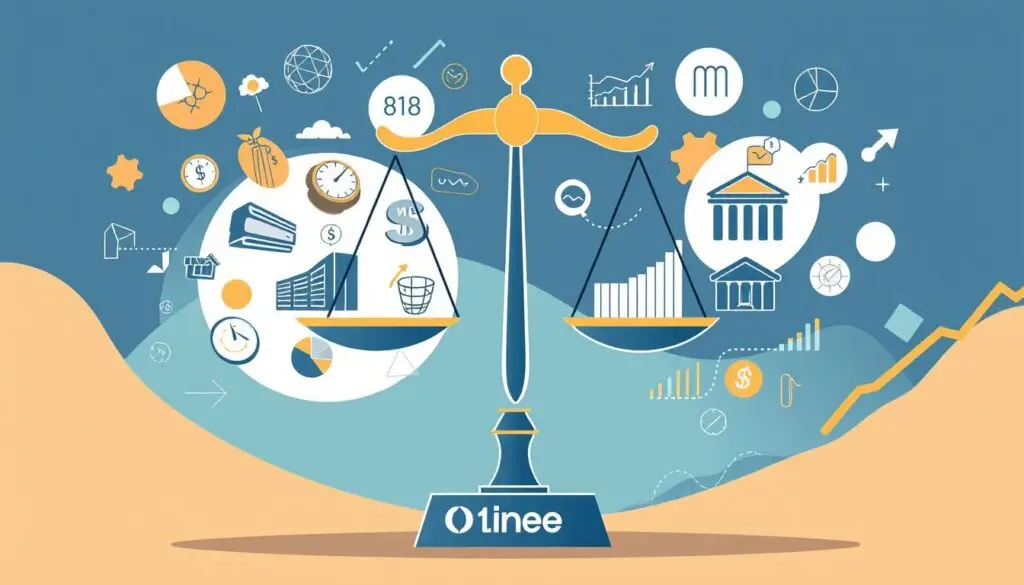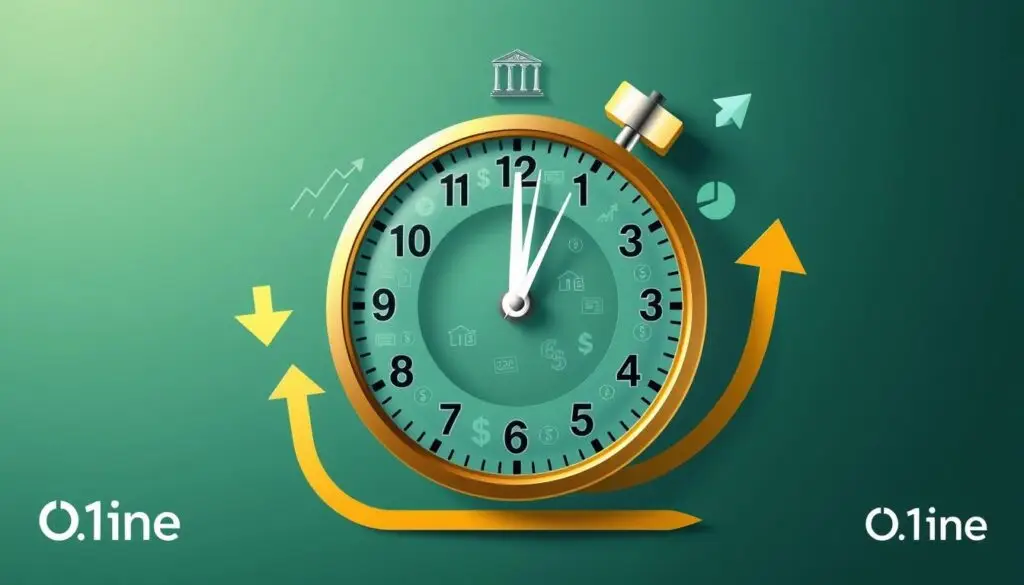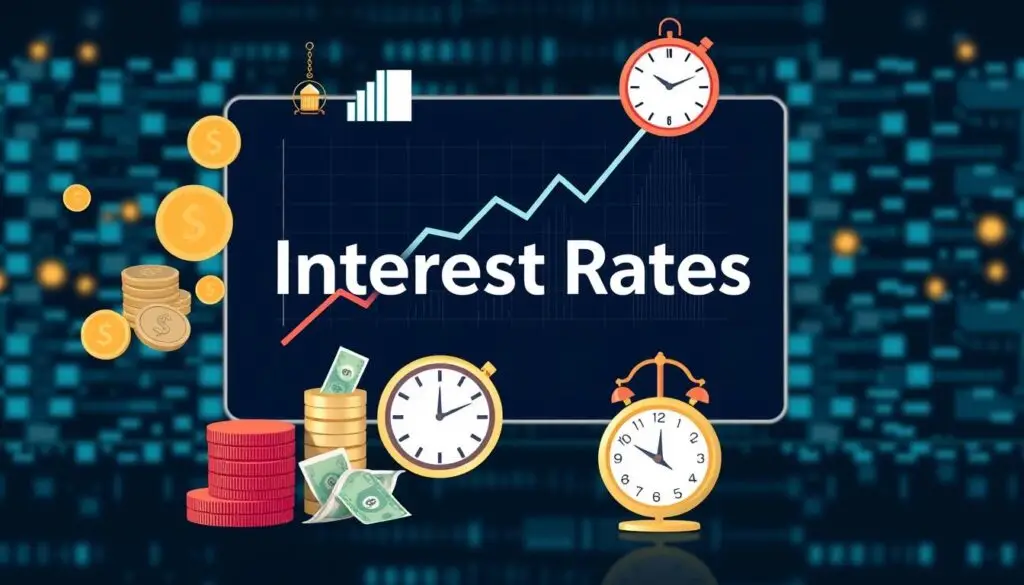At its core, our financial ecosystem is shaped by the dynamics of interest rates. These figures are more than simple percentages; they are the pillars that support our decisions in borrowing, lending, and planning for the future. Whether we are applying for a mortgage, choosing the best savings account, or even contemplating the broader implications of the Federal Reserve’s monetary policy, understanding interest rates is fundamental.
When we talk about interest rates, we are referring to two key concepts: The Annual Percentage Rate (APR) and the Annual Percentage Yield (APY). For anyone taking on a loan, APR becomes a crucial factor as it represents the yearly cost of funds over the term of a loan. Conversely, APY is a beacon for savers and investors, highlighting the potential earnings on their deposits over a year, taking compound interest into account.
Our financially-savvy actions, guided by accurate knowledge of interest rates, enable us to mitigate risks and maximize returns. It is with this understanding that we navigate the monetary landscape, a realm shaped by multifaceted factors influencing both personal financial health and the broader economic climate.
Key Takeaways
- Interest Rates serve as a critical component in personal and business finances.
- APR and APY are essential figures defining the cost of borrowing and the earnings on savings, respectively.
- Interest rates are subject to the influence of the Federal Reserve’s monetary policy.
- The complex relationship between lending, borrowing, and interest rates demands a thorough understanding for effective financial management.
- The calculation of interest rates varies, including simple and compound methods, impacting how much is paid or earned over time.
The Basics of Interest Rates
As we delve into the world of finance, it becomes imperative to understand the core concepts that drive market dynamics and personal finance decisions. Among these are Interest Rates, which play a crucial role in the economics of lending and borrowing. Let’s break down these concepts to see how they impact our choices.
Understanding the Definition of Interest Rate
Interest Rates are essentially the cost of borrowing money. They are usually expressed as a percentage of the principal loan amount, which the borrower needs to pay over a specified period in addition to repaying the principal amount.
The Difference Between APR and APY
The terms APR (Annual Percentage Rate) and APY (Annual Percentage Yield) are crucial in understanding borrowing costs. While APR is used to describe the interest rate for borrowing without taking into account the compounding of interest within that year, APY provides a more accurate picture by including the effects of compound interest.
Simple Interest vs. Compound Interest
The key difference between Simple Interest and Compound Interest lies in their calculations and impact on the total amount paid or earned. Simple interest is calculated only on the principal amount, meaning that it is constant throughout the life of the loan or investment. Conversely, compound interest calculates interest on both the initial principal and the interest that has been added to it over previous periods, which can significantly increase the total interest accumulated over time.
An exploration of these foundational concepts helps us to navigate the financial landscape more effectively, making informed decisions about our investments and loans.
| Type of Interest | Description | Impact on Total Paid/Earned |
|---|---|---|
| Simple Interest | Interest calculated on the principal alone | Increases linearly over time |
| Compound Interest | Interest calculated on principal + accumulated interest | Increases exponentially over time |
How Interest Rates Impact Borrowing and Lending
Understanding how interest rates affect financial decisions is crucial for both individual savers and borrowers, as well as for the larger economic framework. Changes in rates can significantly affect your financial strategy, influencing both borrowing costs and the yield from savings accounts.
Interest Rates on Loans and Mortgages
For those looking to take out loans or secure mortgages, the prevailing mortgage rates are a critical consideration. As lending rates climb, the cost of borrowing naturally increases. This increment in borrowing costs can deter potential homeowners from purchasing properties or dissuade investors from taking on new debts. Conversely, lower mortgage rates make borrowing more accessible and affordable, stimulating property purchases and construction. This cyclical interaction plays a pivotal role in the housing market and broader financial health of consumers.
Effects of Interest Rates on Savings Accounts
Interest rates directly influence the attractiveness of savings accounts. When banks offer higher interest rates, individuals are more inclined to save, as the potential return on their deposited funds increases. This tendency not only boosts personal financial security but also enhances the availability of funds that banks can then lend out. However, when rates are low, the appeal of saving diminishes, potentially increasing consumer spending or investment in higher-risk options.
| Interest Rate Environment | Impact on Borrowing | Impact on Savings |
|---|---|---|
| High Interest Rates | Increased borrowing costs, reduced loan affordability | Increase in saving activity due to higher returns |
| Low Interest Rates | Decreased borrowing costs, increased loan affordability | Decrease in saving activity due to lower returns |
Factors Influencing Interest Rates
Interest rates are vital for maintaining economic stability and encouraging investment. They are influenced by several key factors, including the actions of central banks such as the Federal Reserve and critical economic indicators. Understanding these influences helps demystify the reasons behind fluctuating loan and saving rates.
The Role of the Federal Reserve in Setting Interest Rates
The Federal Reserve plays a fundamental role in shaping monetary policy and managing inflation through the adjustment of interest rates. By altering the benchmark rate, the Federal Reserve guides banks across the country on how to set their own rates for lending and savings. This process is crucial for creating conditions that either stimulate or cool down economic activity based on the current financial climate.
Economic Indicators That Affect Interest Rates
Various economic indicators impact how the Central Banks decide on interest rates, which in turn affect banking, lending, and economic conditions broadly. Key indicators include inflation figures and economic growth rates. Higher inflation generally prompts the Federal Reserve to increase rates to temper economic overheating. Conversely, lower indicators of economic health such as reduced consumer spending or high unemployment might encourage a drop in interest rates to foster borrowing and investing.

The Federal Reserve’s Monetary Policy
At the heart of the U.S. economy, the Federal Reserve plays a pivotal role in shaping monetary policy that aims to modulate interest rates, exert control over inflation, and catalyze economic growth. Through strategic manipulation of financial mechanisms, such as interest rates and the money supply, the Federal Reserve systematically steers the economic landscape toward stability and growth.
Central to their strategy is the dual objective of inflation control and fostering environments conducive to sustainable economic activities. By setting short-term interest rates, the Federal Reserve influences the overall economic climate, affecting everything from consumer spending to business investment. Lower interest rates often lead to more borrowing and spending, while higher rates may slow down economic activities to temper inflation.
| Tool | Function | Impact on Economy |
|---|---|---|
| Interest Rate Adjustments | Modulate borrowing costs | Influences consumer spending and business investments |
| Reserve Requirements | Control the amount of funds banks must hold | Affects the money supply and lending capabilities of banks |
| Open Market Operations | Buy or sell government securities | Directly impacts the national money supply and short-term interest rates |
By understanding and analyzing these tools, we can better comprehend how the Federal Reserve’s decisions on monetary policy filter down to affect individual businesses and the broader economic conditions. It is through this meticulous adjustment of financial levers that the Federal Reserve aims to sustain stability while propelling the nation towards prosperous economic conditions.
Determining Your Personal Interest Rates
When considering personal finance, understanding how personal interest rates are determined is crucial. The nuances of credit scores, lending rates, and other financial habits play a significant role in shaping these rates, directly impacting borrower risk and potential lending opportunities. Here, we will explore the major factors that contribute to individual lending rates.
Credit Scores and Their Impact on Interest Rates
Credit scores are vital in the eyes of lenders. These numerical values represent your creditworthiness and are derived from your credit history, including past payments, credit utilization, and credit account longevity. A higher credit score signals lower borrower risk, often resulting in more favorable lending rates. It’s a direct reflection of your reliability as a borrower and has a profound effect on your personal finance options.
How Your Financial Habits Influence Lending Rates
Aside from credit scores, lenders examine your overall financial habits when determining interest rates. This scrutiny can include analysis of your income stability, existing debts, and your history of saving and spending. Establishing habitually solid financial practices can lead you to benefit from lower lending rates, thus optimizing your personal finance strategy.
| Credit Score Range | Typical Interest Rates | Impact on Borrower |
|---|---|---|
| 750 and above | Low ( | Favorable terms, lower cost of borrowing |
| 700 – 749 | Medium (10% – 15%) | Moderately favorable terms |
| 650 – 699 | High (15% – 20%) | More restrictive terms |
| Below 650 | Very high (> 20%) | Unfavorable terms, high cost of borrowing |
Understanding the Prime Rate
The Prime Rate serves as a critical benchmark in the financial market, influencing various borrowing costs and interest rates across the board. Predominantly, it’s the rate that banks charge their most creditworthy customers, often used as a reference point for different types of loans and credit lines. Understanding how the Prime Rate functions can offer insights into the broader economic landscape, especially in terms of how lenders operate and adjust to changes dictated by the Federal Reserve.

Typically set a few points above the federal funds rate, the Prime Rate directly affects the interest rates that consumers face when engaging in borrowing activities – from credit cards to home mortgages. It reflects the cost of borrowing for lenders and subsequently, impacts various sectors of the economy. By closely monitoring changes in the Prime Rate, both consumers and businesses can make more informed financial decisions.
When the Federal Reserve adjusts interest rates, it aims to influence economic activity and maintain stability. Such adjustments can either incentivize spending through lower rates or moderate spending through higher rates, depending on the economic climate.
| Aspect | Impact of Prime Rate | Relevance to Consumers |
|---|---|---|
| Credit Cards | Direct influence on APRs | Cost of carrying a balance can increase |
| Adjustable-Rate Mortgages | Monthly payments may fluctuate | Important for budgeting and long-term planning |
| Personal Loans | Rates may be tied to the Prime Rate | Influences decision on when to borrow |
Understanding the dynamics of the Prime Rate provides a window into broader economic conditions, helping individuals and businesses better strategize their financial moves in relation to borrowing costs. Hence, staying educated about this benchmark rate is crucial for anyone involved in financial planning or investments.
Interest Rates Explained: Inflation and Its Impact
In today’s economic landscape, one cannot discuss lending rates without addressing the pervasive influence of inflation. As we explore the dynamic between these elements, we delve into the tactics employed by central banks to manage economic changes and strive for economic equilibrium.
How Inflation Influences Lending Rates
Inflation signifies the rate at which the general level of prices for goods and services rises, eroding purchasing power. Central banks monitor inflation to adjust monetary policy appropriately. Typically, a rise in inflation will prompt central banks to increase lending rates, curbing excess spending and borrowing by making it more expensive. Conversely, if inflation rates are low, policies may shift to lower lending rates to encourage borrowing and spending, which can help stimulate the economy.
Strategies Central Banks Use to Manage Inflation
Maintaining economic equilibrium demands constant vigilance and strategic adjustments from central banks. These institutions utilize various tools to control inflation—key among them being the manipulation of interest rates. Additonally, central banks may alter the money supply to impact inflation levels directly. These measures are crucial in stabilizing the economy and achieving a balance that fosters long-term growth and stability.
Understanding these strategies is vital for any stakeholder in the financial markets or anyone impacted by these shifts. Our collective insight into how monetary policy is crafted and executed by central banks can significantly influence our financial decisions and perspectives on the economy.
Understanding Yield Curve and Borrowing Costs
The yield curve is a crucial tool in the financial world, offering insights into interest rates, economic indicators, and borrowing costs. It charts the interest rates of bonds of equal credit quality but differing maturity dates, and its shape provides valuable predictions about economic trends. A normal upward sloping yield curve generally signals expectations of economic growth, while an inverted yield curve might indicate a recession.
- Yield Curve: A graph that compares the yield of bonds with different maturity periods but identical risk levels.
- Interest Rates: The cost of borrowing money, which can influence consumer spending and business investment.
- Borrowing Costs: Expenses incurred by entities while raising funds through bond issuance or loans.
- Economic Indicators: Statistical metrics used to gauge the current status or forecast the future health of the economy, often intertwined with movements in the yield curve.
Understanding the dynamics between these components helps investors and policymakers make informed decisions. The current state of the yield curve can be seen as an early warning system, providing visibility on potential shifts in economic conditions and influencing interest rate policies.
| Yield Curve Type | Implication | Typical Market Condition |
|---|---|---|
| Normal | Healthy Economic Growth | Stable, Growth Oriented |
| Inverted | Potential Economic Downturn | Uncertainty, Possible Recession |
| Flat | Uncertain Economic Outlook | Mixed Signals, Transition Phase |
This understanding empowers us to predict changes in borrowing costs and prepare for shifts in economic conditions, illustrating how closely interconnected these elements are and underscoring the importance of the yield curve as both an economic indicator and a tool for financial planning.
Global Interest Rates: Comparing Central Banks
As we explore the landscape of global interest rates, it’s crucial to understand how central banks around the world vary in their approach to monetary policy. The architect of such policies, the central banks, play a pivotal role in shaping economic stability in their respective countries. By comparing these institutions, particularly the Federal Reserve, with its counterparts across the globe, we gain insights into the complex interplay of international monetary policy and global economic trends.
Interest Rates Decisions Around the World
Each central bank, influenced by domestic economic conditions, inflation rates, and other financial indicators, takes a unique stance on interest rates. These decisions reflect the needs and goals of their national economies. For instance, during periods of economic recession, central banks might lower interest rates to encourage borrowing and stimulate spending, whereas in times of high inflation, they may increase rates to cool down economic activity.
Comparing the US Federal Reserve to Other Central Banks
The Federal Reserve, known for its significant influence on global finance, often sets trends that other central banks might follow. However, the extent to which its policies align with, or diverge from, other banks can vastly impact international monetary policy. For example, when the Federal Reserve raises its rates, emerging markets might suffer capital outflows as investors chase higher returns in the US, impacting global interest rates.
Central banks worldwide monitor the Federal Reserve’s actions closely, as these can have far-reaching effects on their own monetary policy decisions and economic stability.
This reflection on global interest rates and the critical role of central banks in shaping them offers us a broader perspective on the dynamics of international finance, underscoring the interconnectedness of today’s economies.
The Effect of Quantitative Easing on Interest Rates
In our exploration of the dynamic financial landscape, we delve into the realm of Quantitative Easing, a strategic tool utilized by Central Banks to influence the economy. This monetary policy involves the purchasing of longer-term securities from the open market, a move designed to increase the money supply and foster a conducive environment for lending and investment. But, how does this method affect Interest Rates? By pumping more capital into the economy, central authorities aim to lower the cost of borrowing. This deliberate Monetary Expansion serves as a stimulus, especially during times when economic activities show signs of stagnation or when recessionary pressures loom large.
As we scrutinize Quantitative Easing further, it’s evident that this action does more than just adjust Interest Rates; it has a sweeping impact across various sectors. For instance, lower Interest Rates directly translate to more accessible mortgage rates for homeowners. Similarly, the cost of borrowing for governments can decrease, making it less expensive to fund public projects and initiatives. This potential easing of financial conditions encourages both individuals and countries to invest in growth opportunities, thereby stimulating the overall economy. It is a fine balance, however, as Central Banks must carefully navigate the potential for inflation that can arise from such expansionary policies.
Our understanding of Quantitative Easing and its effects on Interest Rates unveils the intricate mechanisms Central Banks employ to nurture economic stability and growth. Through such expansion of the money supply, we recognize the intent to make borrowing more affordable and to boost investment. By dissecting these sophisticated strategies, we grasp the magnitude of Monetary Expansion’s role in charting the course of our economy—highlighting the interwoven relationship between central policy decisions and the financial wellbeing of society at large.







